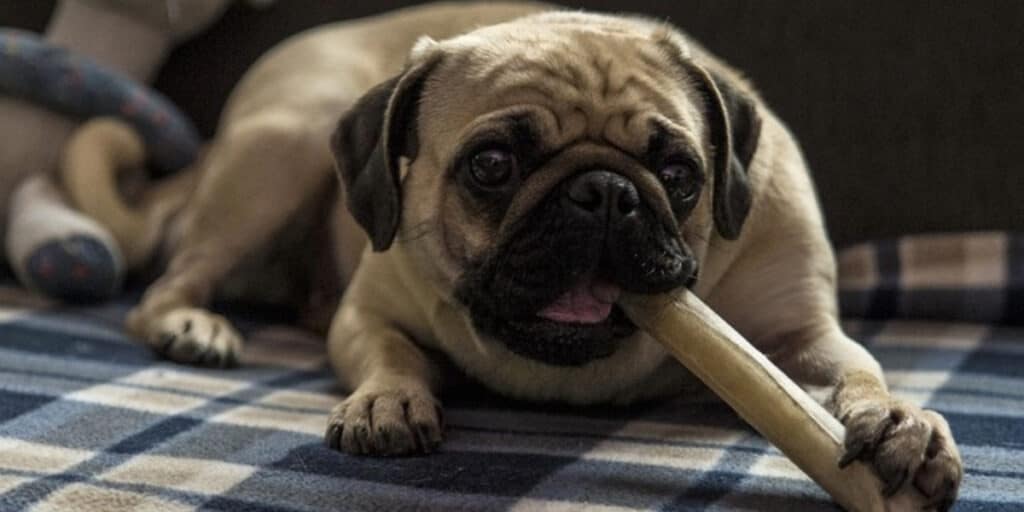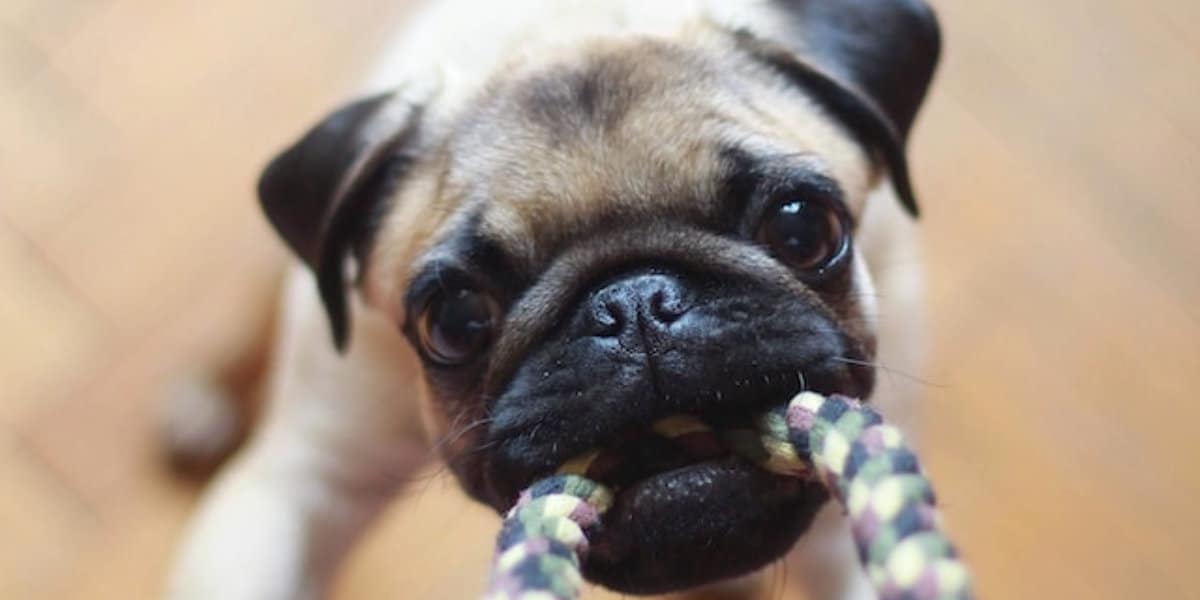As a pug dog owner, it’s essential to understand your dog’s behavior to provide the best care and ensure their safety. Pugs are known for their playful and affectionate nature, and they can indeed be chewers, especially during their puppy stage.
If not managed correctly, Pugs can become destructive and cause damage to your furniture, clothes, and shoes. This blog post will help you understand why pugs like to chew and provide you with tips to manage their chewing behavior.
Why Do Pugs Like to Chew?
Pugs are endearing little dogs that have earned a reputation as being some of the best companions you can have. However, as lovely as they are, they do certain things that can be a little frustrating for their owners. One of the most common behavioral patterns that pug owners encounter is chewing. But have you ever stopped to wonder why do pugs like to chew? Here are 5 reasons why:
1. It’s a natural instinct: Pugs and many other dog breeds have a natural urge to chew as it’s part of their innate behavior. Chewing helps keep their teeth clean, strengthens their jaws, and provides mental stimulation when they are bored or feeling anxious.
2. To explore: Pugs are curious little dogs that love to explore their surroundings. Chewing is a way for them to learn more about their environment and their toys. It’s like giving them a way to understand what everything around them tastes, feels, and smells like.
3. To relieve stress: Just like human beings, dogs can become stressed or anxious. Chewing, in this case, acts as a coping mechanism that provides a calming effect and helps reduce stress levels. It can be a way for pugs to channel their nervous energy and find solace in their toys or chews.
4. Teething: For puppies, chewing is even more important. During the teething phase, puppies experience discomfort as their teeth start growing, and chewing gives them some relief. Chewing can also help puppies develop good dental health as they grow older.
5. Attention-seeking: Finally, pugs may chew to get attention from their owners. If your pug is feeling neglected or bored, they may start chewing or destroying things to get your attention. In such cases, it is recommended to give them attention during positive activities, like playtime or training sessions, instead of giving in to their negative behavior.
Chewing in pugs is not necessarily a bad habit. It’s a natural behavior that serves a variety of purposes. As a responsible owner, it’s important to provide your pug with appropriate chew toys, establish routine dental care, and give them positive attention and interaction.
At What Age Do Pugs Stop Chewing
Pugs love to chew, and if you are a pug owner, you might be wondering when your pug’s chewing phase will end.
Pugs enjoy chewing on anything and everything, from shoes to furniture to toys. But as pugs grow older, they tend to chew less and less. Most pugs will stop chewing completely by the time they reach 2 years of age. However, some pugs may continue to chew until they are 3 or 4 years old.
There are several reasons why pugs stop chewing as they grow older. One reason is that their teeth and jaw muscles become stronger, allowing them to chew more effectively. Another reason is that as pugs grow older, they become more mature and are less likely to chew out of boredom or anxiety.
How to Manage Your Pug’s Chewing Behavior
As a pug owner you may have found yourself frustrated with the destruction caused by their chewing behavior.
Fortunately, there are steps you can take to manage and redirect your pug’s chewing tendencies. We will discuss some tips and tricks for managing your pug’s chewing behavior below.
1. Provide Appropriate Chewing Toys:
First and foremost, it’s important to provide your pug buddy with appropriate chewing toys. A pug that doesn’t have access to acceptable chew toys may turn to household items or furniture to satisfy their chewing needs.
Make sure to give your pug durable chew toys, like rubber balls, bones, and rawhide chews. Be cautious of the toys you choose as they should be age and size-appropriate to avoid choking hazards.
2. Supervision:
Another important step in managing your pug’s chewing behavior is through supervision. When your pug is left alone or unsupervised, their curiosity may lead to mischief. It’s advisable to keep them in a designated area, preferably with their toys, and with a baby gate or pen.
Additionally, you can choose to encourage your pug’s good behavior through positive reinforcement such as with treats.
3. Deterrent Spray:
Pugs are intelligent dogs, but they can be stubborn when it comes to persistent behaviors like chewing. A deterrent spray can aid in breaking your pug’s habit of chewing furniture, shoes, or other off-limits items. The bitter taste of the spray on household items will deter them away from harmful behavior.
4. Exercise Regularly:
Exercise is an essential way to manage a pug’s destructive behavior, especially those caused by separation anxiety. When they are exercised regularly, they are less likely to seek out destructive behaviors when alone. An exercise routine of a walk once or twice a day can relieve their stress and give them confidence.
5. Professional Help:
If you’ve tried all of the above and your pug’s chewing behavior persists, it’s best to consider seeking the advice of a professional like a certified trainer or a veterinarian to help address the underlying causes of their behavior.
They can identify potential medical, emotional, or psychological issues and provide solutions and medications to help improve your pug’s behavior.
Pugs are adorable dogs, but their chewing tendencies can be challenging to manage. Keeping them entertained with appropriate toys, exercising regularly to reduce anxiety, and using deterrent sprays are effective ways to manage your pug’s chewing behavior.
Always supervise and give positive reinforcement to encourage good behavior. Remember that seeking professional help is not a sign that you’re a bad owner, but the best way to help your furry friend adjust to a happy and healthy life.

What Not to Do When Pugs Chew
Destructive chewing is common in pugs, especially in their early years. Pugs tend to chew on everything in their reach that fits in their mouth is fair game for them. As much as this behavior can be frustrating, it’s essential to handle it with care and not make it worse.
1. Don’t resort to punishment.
Punishing your pug for chewing on things is not the solution—it will only increase their anxiety and make the behavior worse. Avoid hitting, yelling, or any other form of physical punishment to deter your pug from chewing. Instead, redirect their attention to a more appropriate chew item when you catch them chewing on something they’re not supposed to.
2. Don’t make a big fuss about it.
Dogs respond to attention, and even negative attention can be rewarding for them. If you constantly scold or shout at your pug for chewing, they may see it as a sign of attention and continue the behavior. Rather than making a scene, find ways to discourage the behavior without being too noticeable.
3. Don’t assume your pug will grow out of it.
As much as we’d like to think that our dogs will outgrow destructive chewing, it’s not always the case. Pugs that have developed a habit of chewing will continue to do so unless proper measures are taken. Be patient and work on correcting the behavior with positive reinforcement and consistent training.
4. Don’t give your pug free rein.
Supervision is essential to preventing destructive chewing in pugs. When you’re not around to keep an eye on your pug, confine them to a specific area—such as a crate or a baby gate—to limit their access to items they shouldn’t be chewing on.
Additionally, make sure to puppy-proof your home and remove anything that may be tempting for your pug to chew.
5. Don’t neglect their dental health.
Sometimes, chewing may be a sign of an underlying dental problem. Regular dental check-ups with a veterinarian can identify any issues that may be causing your pug to chew more than usual. Additionally, providing your pug with appropriate chew toys can improve their dental hygiene while also keeping them entertained.
Destructive chewing is a common issue that pug owners face, but it’s important to approach it with the right mindset and strategy. Avoiding these common mistakes can help you prevent the behavior from escalating and ensure that your pug adjusts favorably. Patience, consistency, and positivity are key to correcting destructive chewing in pugs.
Remember that every pug is different, and what works for one may not work for others. If you’re struggling with this behavior, don’t hesitate to seek professional help from a veterinarian or a certified dog trainer. With the right approach and effort, you can help your pug overcome their chewing habit and live a happy, healthy life.
pugs can be chewers, but with proper understanding and management, you can control your pug’s chewing behavior and keep your valuables and pug safe. Providing appropriate toys, supervision, exercise, and consulting a veterinarian when necessary, can help prevent destructive chewing. Remember, a well-cared-for pug is a happy and healthy pug.

